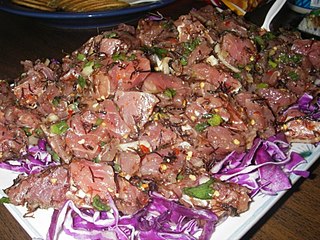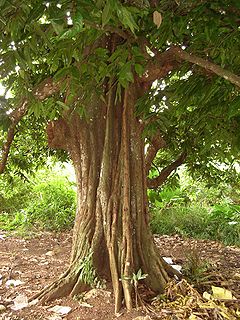 W
WBreadfruit is a species of flowering tree in the mulberry and jackfruit family (Moraceae) believed to be a domesticated descendant of Artocarpus camansi originating in New Guinea, the Maluku Islands, and the Philippines. It was initially spread to Oceania via the Austronesian expansion. It was further spread to other tropical regions of the world during the Colonial Era. British and French navigators introduced a few Polynesian seedless varieties to Caribbean islands during the late 18th century. Today it is grown in some 90 countries throughout South and Southeast Asia, the Pacific Ocean, the Caribbean, Central America and Africa. Its name is derived from the texture of the moderately ripe fruit when cooked, similar to freshly baked bread and having a potato-like flavor.
 W
WThe cuisine of Hawaii incorporates five distinct styles of food, reflecting the diverse food history of settlement and immigration in the Hawaiian Islands.
 W
WAn earth oven, ground oven or cooking pit is one of the simplest and most ancient cooking structures. At its most basic, an earth oven is a pit in the ground used to trap heat and bake, smoke, or steam food. Earth ovens have been used in many places and cultures in the past, and the presence of such cooking pits is a key sign of human settlement often sought by archaeologists. Earth ovens remain a common tool for cooking large quantities of food where no equipment is available. They have been used in various civilizations around the world and are still commonly found in the Pacific region to date.
 W
WFe'i bananas are cultivated plants in the genus Musa, used mainly for their fruit. Unlike most other cultivated bananas they are diploids of the AA-type. They are very distinct in appearance and origin from the majority of bananas and plantains currently grown. Found mainly in the islands of the Pacific, particularly French Polynesia, Fe'i bananas have skins which are brilliant orange to red in colour with yellow or orange flesh inside. They are usually eaten cooked and have been an important food for Pacific Islanders, moving with them as they migrated across the ocean. Most are high in beta-carotene.
 W
WFicus tinctoria, also known as dye fig, or humped fig is a hemiepiphytic tree of genus Ficus. It is also one of the species known as strangler fig.
 W
WʻInamona is a condiment or relish used in traditional Hawaiian cooking made from roasted kukui nut (candlenuts) and sea salt. It is sometimes mixed with seaweeds, often accompanying meals.
 W
WInocarpus fagifer, commonly known as the Tahitian chestnut or Polynesian chestnut, is a species of flowering plant in the subfamily Faboideae of the legume family, Fabaceae. The tree has a wide range in the tropics of the south-west Pacific and south-east Asian regions, and a history of traditional use by the peoples of Polynesia and Melanesia. It is the only edible and culturally important member of the genus Inocarpus.
 W
WKava or kava kava is a crop of the Pacific Islands. The name kava is from Tongan and Marquesan, meaning 'bitter'; other names for kava include ʻawa (Hawaiʻi), ʻava (Samoa), yaqona or yagona (Fiji), sakau (Pohnpei), seka (Kosrae), and malok or malogu. Kava is consumed for its sedating effects throughout the Pacific Ocean cultures of Polynesia, including Hawaii, Vanuatu, Melanesia, and some parts of Micronesia, such as [Pohnpei & Kosrae]. Kava can be used for medicinal purposes to treat anxiety.
 W
WKūlolo is a Hawaiian dessert made primarily with baked or steamed grated taro corms and either with grated coconut meat or coconut milk. Considered a pudding, kūlolo has a solid consistency like fudge and is often served cut into squares. Its consistency is also described as chewy and lumpy like tapioca, and it tastes similar to caramel.
 W
WLaulau, otherwise known as Lū in Tonga, Palusami in Fiji and Samoa and Rukau in the Cook Islands, is a Polynesian dish consisting of cooked taro leaves containing fillings such as pork, fish or coconut cream. In old Hawaiʻi, laulau was assembled by taking a few leaves and placing a few pieces of fish and pork in the center. In modern times, the dish uses taro leaves, salted butterfish, and either pork, beef, or chicken and is usually steamed on the stove. Laulau is a typical plate lunch dish and is usually served with a side of rice and macaroni salad.
 W
WLimu, otherwise known as rimu or ʻimu is a general Polynesian term for edible plants living underwater, such as seaweed, or plants living near water, like algae. In Hawaii, there are approximately one hundred names for kinds of limu, sixty of which can be matched with scientific names. Hundreds of species or marine algae were once found in Hawaii. Many limu are edible, and used in the cuisine throughout most of Polynesia.
 W
WLūʻau, known alternatively as Poulet fafa in French Polynesia, Rourou in Fiji and Rukau in the Cook Islands is a traditional Polynesian stew. The name of this dish in Hawaii and other parts of the pacific is derived from its main ingredient, Taro leaves, which are cooked down and coconut milk added. Variations of this dish differ between islands. In Hawaii, octopus is added to this dish alongside onion and garlic, the dish being referred to as Squid Lū'au.
 W
WNative Hawaiian cuisine refers to the traditional Hawaiian foods that predate contact with Europeans and immigration from East and Southeast Asia. The cuisine consisted of a mix of indigenous plants and animals as well as plants and animals introduced by Polynesian voyagers, who became the Native Hawaiians.
 W
WNew Zealand cuisine is largely driven by local ingredients and seasonal variations. An island nation with a primarily agricultural economy, New Zealand yields produce from land and sea. Similar to the cuisine of Australia, the cuisine of New Zealand is a diverse British-based cuisine, with Mediterranean and Pacific Rim influences as the country becomes more cosmopolitan.
 W
WNiue is an island in the Southern Pacific, mostly inhabited by Polynesians. The plantations are mostly filled with manioc, taro and breadfruit, but banana trees can be found. The wide range of exotic plants in Niue includes taros, pawpaw, coconuts, bananas, yams, cassavas and breadfruits: All are intensively used in the local cuisine.
 W
WOta ika is a Polynesian dish consisting of raw fish marinated in citrus juice and coconut milk. The Tongan, Tahitian, and Samoan variants are essentially identical in that the raw fish is briefly marinated in lemon or lime juice until the surface of the flesh becomes opaque. The fish is then mixed with coconut milk and diced vegetables. This is the national dish of Tonga.
 W
Wʻotai is a drink which originated in western Polynesia and is usually made as a refreshing accompaniment to large meals.
 W
WPandanus tectorius is a species of Pandanus (screwpine) that is native to Malesia, eastern Australia, and the Pacific Islands. It grows in the coastal lowlands typically near the edge of the ocean. Common names in English include thatch screwpine, Tahitian screwpine, hala tree, pandanus, and pu hala in Hawaiian. The fruit is sometimes known as hala fruit.
 W
WPascuense cuisine, otherwise known as Easter Island cuisine or Rapa Nui cuisine incorporates the influences of the indigenous Rapa Nui people and Latin America. Notable ingredients include seafood such as fish, octopus (heke), eel, sea snails (pipi) and crustaceans (lobster), as well as sweet potato, taro, banana, pineapple, coconut, pumpkin, and poultry, pork and lamb meat.
 W
WThe Pitcairn Islands, officially the Pitcairn, Henderson, Ducie and Oeno Islands, also known as British Polynesia, is a group of four volcanic islands in the southern Pacific Ocean that form the sole British Overseas Territory in the Pacific Ocean. The four islands—Pitcairn, Henderson, Ducie, and Oeno—are scattered across several hundred miles of ocean and have a combined land area of about 18 square miles (47 km2). Henderson Island accounts for 86% of the land area, but only Pitcairn Island is inhabited. The islands nearest to the Pitcairn Islands are Mangareva to the west and Easter Island to the east.
 W
WPoi or Popoi is a traditional staple food in the Polynesian diet, made from starchy vegetables, usually breadfruit, taro or plantain.
 W
WSweet potato cultivation in Polynesia as a crop began around 1000 AD in central Polynesia. The plant became a common food across the region, especially in Hawaii, Easter Island and New Zealand, where it became a staple food. By the 1600s in central Polynesia, traditional cultivars were being replaced with hardier and larger varieties from the Americas. Many traditional cultivars are still grown across Polynesia, but they are rare and are not widely commercially grown.
 W
WThe cuisine of Tuvalu, a state in the Central Pacific (Oceania), is based on the staple of coconut and the many species of fish found in the ocean and the lagoons of the atolls of Tuvalu. Pulaka,, or swamp taro, is an important source of carbohydrates. Rice now forms an important part of the diet. Coconut is used in different forms with coconut water, coconut milk and the flesh of the coconut being used to flavour dishes. Various desserts made on the islands include coconut and coconut milk, instead of animal milk.